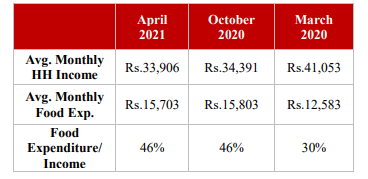The biggest challenge for the government on the economic front now is dealing with inflation. High inflation amid sticky wages are squeezing consumers’ buying power more and more – and hence dampening consumer sentiment despite the revival in economic growth (For more read: Growth Perceptions). The main contributor to inflation is the food component with prices of perishable food items continuing to be on elevated plane.
With no respite in inflation, those at the bottom of the pyramid are the most vulnerable; low-income households spend a much higher percentage of their income on food versus the middle- and high-income groups. The impact of higher inflation on the low-income group is profound and far reaching, and COVID-19 containment measures has further disproportionately affected these households. A recent research conducted by Kashf Foundation: Food Inflation and Impact on Low Income Households studies show how rising food prices have put pressure on low-income households, forcing them to change their spending patterns and priorities to cope with the challenge.

The survey spans the changes in business activity and household income over six months till April 2021 compared with finding from earlier survey in October 2020 and April 2020 of its clientele. The findings of the research show that the average monthly income of a typical household in the low-income category declined – the decline from April 2020 till April 2021 was over 17 percent, while their monthly food expenditure has risen by around 25 percent over the same period. This relationship is also shown as food expenditure to income ratio which increased from 30 to 46 percent.
The study also shows that the business activity in April 2021 survey as well as October 2020 survey decreased, but the intensity was lower in recent period as businesses suffered larger losses in the six months following the first lockdown in March 2020 versus the recovery seen in the economy during the time period for the recent survey.
The incidence of sticky wages can be seen from the finding that despite a larger percentage of respondents reporting improvement in business activity in April 2021 compared to October 2020, more respondents reported a decrease in the household income. This shows that while the economy was recovering, income sources have been slower to increase or revert back to their original levels. Covid’s impact can be assessed by the fact that majority of the household income have not fully recovered to pre-lockdown levels – this is 78 percent in urban respondents, 73 percent semi-urban and 66 percent rural settings.

From the food expense point of view, majority (84%) of the households surveyed cited food expense as the largest expense in their bucket, and over 70 percent stating that the rise in food prices has been exorbitant. Total expenditure on food has also increased from a high of 73 percent in October 2020 survey to over 90 percent in April 2021 survey showing that food inflation has been unwavering.
The finding of the coping mechanisms used by the households are the most disturbing – showing how food inflation could have adverse impact on these low-income households in the long run. Key methods and ways that the households adopted to deal with the inflationary pressures amid low income and sticky wages have been reduction in the quality and quantity of food consumed, cut back in expenses, and taking children out of school and sending them for domestic work. These ways of coping speak of the desperation of low-income households to remain afloat.






















Comments
Comments are closed.